Model-Based Selection of Cost-Effective Low Impact Development Strategies to Control Water Balance
Abstract
1. Introduction
2. Materials and Methods
2.1. Case Studies and Data
2.2. Investigated LID strategies and Model Development
2.3. Relations between Water Balance, Life Cycle Costs, and Demand for Land
2.4. Assessment and Efficiency of LID Strategies
3. Results and Discussion
3.1. Relations between Water Balance, Life Cycle Costs, and Demand for Land
3.1.1. Single LID Strategies
3.1.2. Two-Part LID Treatment Train with Green Roof
3.1.3. Two-Part LID Treatment Train: Infiltration Swale—Infiltration Trench
3.1.4. Two-Part LID Treatment Train: Infiltration swale—Blind Drain
3.1.5. Three-Part LID Treatment Train: Green Roof—Infiltration Swale—Blind Drain
3.2. Assessment and Efficiency of LID Strategies
4. Conclusions
Author Contributions
Funding
Acknowledgments
Conflicts of Interest
References
- Shuster, W.D.; Bonta, J.; Thurston, H.; Warnemuende, E.; Smith, D.R. Impacts of impervious surface on watershed hydrology: A. review. Urban Water J. 2005, 2, 263–275. [Google Scholar] [CrossRef]
- Cheng, S.J.; Wang, R.Y. An approach for evaluating the hydrological effects of urbanization and its application. Hydrol. Process. 2002, 16, 1403–1418. [Google Scholar] [CrossRef]
- Haase, D. Effects of urbanisation on the water balance—A long-term trajectory. Environ. Impact Assess. Rev. 2009, 29, 211–219. [Google Scholar] [CrossRef]
- Fletcher, T.D.; Andrieu, H.; Hamel, P. Understanding, management and modelling of urban hydrology and its consequences for receiving waters: A state of the art. Adv. Water Resour. 2013, 51, 261–279. [Google Scholar] [CrossRef]
- US EPA. Low Impact Development (LID)—A Literature Review; US EPA Office of Water (4203): Washington, DC, USA, 2000.
- Ahiablame, L.M.; Engel, B.A.; Chaubey, I. Effectiveness of low impact development practices: Literature review and suggestions for future research. Water Air Soil Pollut. 2012, 223, 4253–4273. [Google Scholar] [CrossRef]
- Eckart, K.; McPhee, Z.; Bolisetti, T. Performance and implementation of low impact development—A review. Sci. Total Environ. 2017, 607, 413–432. [Google Scholar] [CrossRef]
- Jayasooriya, V.M.; Ng, A.W.M. Tools for Modeling of Stormwater Management and Economics of Green Infrastructure Practices: A Review. Water Air Soil Pollut. 2014, 225, 2055. [Google Scholar] [CrossRef]
- Rossman, L. Storm Water Management Model—User’s Manual Version 5.1; US EPA Office of Research and Development: Washington, DC, USA, 2015.
- DWA. Arbeitsblatt DWA-A 138—Planung, Bau und Betrieb von Anlagen zur Versickerung von Niederschlagswasser; Deutsche Vereinigung für Wasserwirtschaft, Abwasser und Abfall e.V.: Hennef, Germany, 2005. [Google Scholar]
- ON. ÖNORM B 2506-1: Regenwasser-Sickeranlagen für Abläufe von Dachflächen und befestigten Flächen—Teil 1: Anwendung, hydraulische Bemessung, Bau und Betrieb; Austrian Standards: Vienna, Austria, 2013. [Google Scholar]
- MDE. Maryland Stormwater Design Manual; Maryland Department of the Environment (MDE): Baltimore, MD, USA, 2000.
- Ballard, B.W.; Udale-Clarke, H.; Kellagher, R.; Dou, V.; Powers, D.; Gerolin, A.; McCloy, A.; Schmitt, T. International approaches to the hydraulic control of surface water runoff in mitigating flood and environmental risks. E3S Web Conf. 2016, 7, 12004. [Google Scholar] [CrossRef]
- Leimgruber, J.; Krebs, G.; Camhy, D.; Muschalla, D. Sensitivity of Model-Based Water Balance to Low Impact Development Parameters. Water 2018, 10, 1838. [Google Scholar] [CrossRef]
- Coffman, L. Low-Impact Development Design Strategies, An Integrated Design Approach; Department of Environmental Resources, Programs and Planning Division: Prince George’s County, MD, USA, 2000. [Google Scholar]
- Seo, M.; Jaber, F.; Srinivasan, R. Evaluating various low-impact development scenarios for optimal design criteria development. Water Switz. 2017, 9, 270. [Google Scholar] [CrossRef]
- Goebel, P.; Coldewey, W.G.; Dierkes, C.; Kories, H.; Meßer, J.; Meißner, E. Impacts of green roofs and rain water use on the water balance and groundwater levels in urban areas. Grundwasser 2007, 12, 189–200. [Google Scholar] [CrossRef]
- Henrichs, M.; Langner, J.; Uhl, M. Development of a simplified urban water balance model (WABILA). Water Sci. Technol. 2016, 73, 1785–1795. [Google Scholar] [CrossRef]
- Henrichs, M.; Steinbrich, A.; Leistert, H.; Scherer, I.; Schuetz, T.; Uhl, M.; Weiler, M. Model Based Estimation of a Natural Water Balance as Reference for Planning in Urban Areas. In New Trends in Urban Drainage Modelling—UDM 2018, Proceedings of International Conference on Urban Drainage Modelling, Palermo, Italy, 23–26 September 2018; Springer International Publishing: Cham, Switzerland, 2019; pp. 953–957. [Google Scholar]
- Burns, M.J.; Fletcher, T.D.; Walsh, C.J.; Ladson, A.R.; Hatt, B.E. Hydrologic shortcomings of conventional urban stormwater management and opportunities for reform. Landsc. Urban Plan. 2012, 105, 230–240. [Google Scholar] [CrossRef]
- Kim, R.; Lee, J.; Lee, D. Development of Treatment-Train-Package Novel System for the Road Runoff Controlling in Urban Area. Int. J. Control. Autom. 2015, 8, 155–162. [Google Scholar] [CrossRef]
- Xu, C.; Hong, J.; Jia, H.; Liang, S.; Xu, T. Life cycle environmental and economic assessment of a LID-BMP treatment train system: A case study in China. J. Clean. Prod. 2017, 149, 227–237. [Google Scholar] [CrossRef]
- She, N.; Liu, J.; Lucas, W.; Li, T.; Wu, L. Performance of LID Treatment Trains in Shenzhen University during Extreme Storm Events. In Proceedings of the International Low Impact Development Conference 2015, Houston, TX, USA, 19–21 January 2015. [Google Scholar]
- Auger, S.; Van Seters, T.; Singh, A.; Antoszek, J. Water Quality Target Assessment Using LID TTT for Better SWM Designs in Ontario. In Proceedings of the International Low Impact Development Conference 2018, Nashville, TN, USA, 12–15 August 2018. [Google Scholar]
- MacMullan, E.; Reich, S. The Economics of Low-Impact Development: A Literature Review; ECONorthwest: Eugene, OR, USA, 2007. [Google Scholar]
- Liao, Z.; Chen, H.; Huang, F.; Li, H. Cost–effectiveness analysis on LID measures of a highly urbanized area. Desalin. Water Treat. 2015, 56, 2817–2823. [Google Scholar] [CrossRef]
- Chui, T.F.M.; Liu, X.; Zhan, W. Assessing cost-effectiveness of specific LID practice designs in response to large storm events. J. Hydrol. 2016, 533, 353–364. [Google Scholar] [CrossRef]
- Montalto, F.; Behr, C.; Alfredo, K.; Wolf, M.; Arye, M.; Walsh, M. Rapid assessment of the cost-effectiveness of low impact development for CSO control. Landsc. Urban Plan. 2007, 82, 117–131. [Google Scholar] [CrossRef]
- Houdeshel, C.; Pomeroy, C.; Hair, L.; Moeller, J. Cost-Estimating Tools for Low-Impact Development Best Management Practices: Challenges, Limitations, and Implications. J. Irrig. Drain. Eng. 2010, 137, 183–189. [Google Scholar] [CrossRef]
- Yu, Z.; Aguayo, M.; Montalto, F.; Piasecki, M.; Behr, C. Developments in LIDRA 2.0: A Planning Level Assessment of the Cost-Effectiveness of Low Impact Development. In Proceedings of the World Environmental and Water Resources Congress 2010, Providence, RI, USA, 16–20 May 2010; pp. 3261–3270, ISBN 978-0-7844-1114-8. [Google Scholar]
- OEWAV. ÖWAV—Leitfaden—Niederschlagsdaten zur Anwendung der ÖWAV-Regelblätter 11 und 19; Österreichischer Wasser-und Abfallwirtschaftsverband: Vienna, Austria, 2007. [Google Scholar]
- Hargreaves, G.H.; Samani, Z.A. Reference Crop Evapotranspiration from Temperature. Appl. Eng. Agric. 1985, 1, 96–99. [Google Scholar] [CrossRef]
- ZAMG. Jahrbuch—ZAMG. Available online: https://www.zamg.ac.at/cms/de/klima/klimauebersichten/jahrbuch (accessed on 28 November 2017).
- Rossman, L.A.; Huber, W.C. Storm Water Management Model Reference Manual Volume III—Water Quality; US EPA National Risk Management Research Laboratory: Cincinnati, OI, USA, 2016.
- FLL. Dachbegrünungsrichtlinie—Richtlinie für die Planung Ausführung und Pflege von Dachbegrünungen; Forschungsgesellschaft Landschaftsentwicklung und Landschaftsbau e.V.: Bonn, Germany, 2008. [Google Scholar]
- Rossman, L.A.; Huber, W.C. Storm Water Management Model Reference Manual Volume I—Hydrology; US EPA National Risk Management Research Laboratory: Cincinnati, OI, USA, 2016.
- Leitlinien zur Durchführung dynamischer Kostenvergleichsrechnungen (KVR-Leitlinien); 8. überarb. Aufl.; Deutsche Vereinigung für Wasserwirtschaft, Abwasser und Abfall, Ed.; DWA: Hennef, Germany, 2012; ISBN 978-3-941897-55-7. [Google Scholar]
- Leimbach, S.; Brendt, T.; Ebert, G.; Jackisch, N.; Zieger, F.; Kramer, S. Regenwasserbewirtschaftungsanlagen in der Praxis: Betriebssicherheit, Kosten und Unterhaltung; Universität.: Freiburg, Germany, 2018. [Google Scholar]
- Matzinger, A.; Riechel, M.; Remy, C.; Schwarzmüller, H.; Rouault, P.; Schmidt, M.; Offermann, M.; Strehl, C.; Nickel, D.; Sieker, H.; et al. Zielorientierte Planung von Maßnahmen der Regenwasserbewirtschaftung—Ergebnisse des Projektes KURAS; Konzepte für urbane Regenwasserbewirtschaftung und Abwassersysteme: Berlin, Germany, 2017. [Google Scholar]
- Sieker Sieker—Die Regenwasserexperten. Available online: https://www.sieker.dede/home.html (accessed on 5 December 2018).
- Muschalla, D.; Gruber, G.; Scheucher, R. ECOSTORMA—Handbuch—Ökologische und ökonomische Maßnahmen der Niederschlagswasserbewirtschaftung; Ministerium für ein lebenswertes Österreich: Wien, Germany, 2014. [Google Scholar]
- Schuetze, M.; Butler, D.; Beck, M.B. Modelling, Simulation and Control of Urban Wastewater Systems; Springer: London, UK, 2002; ISBN 1-85233-553-X. [Google Scholar]
- Youcan, F.; Steven, B. Improving Evapotranspiration Mechanisms in the U.S. Environmental Protection Agency’s Storm Water Management Model. J. Hydrol. Eng. 2016, 21, 06016007. [Google Scholar]
- Dietz, M.E. Low Impact Development Practices: A Review of Current Research and Recommendations for Future Directions. Water. Air. Soil Pollut. 2007, 186, 351–363. [Google Scholar] [CrossRef]

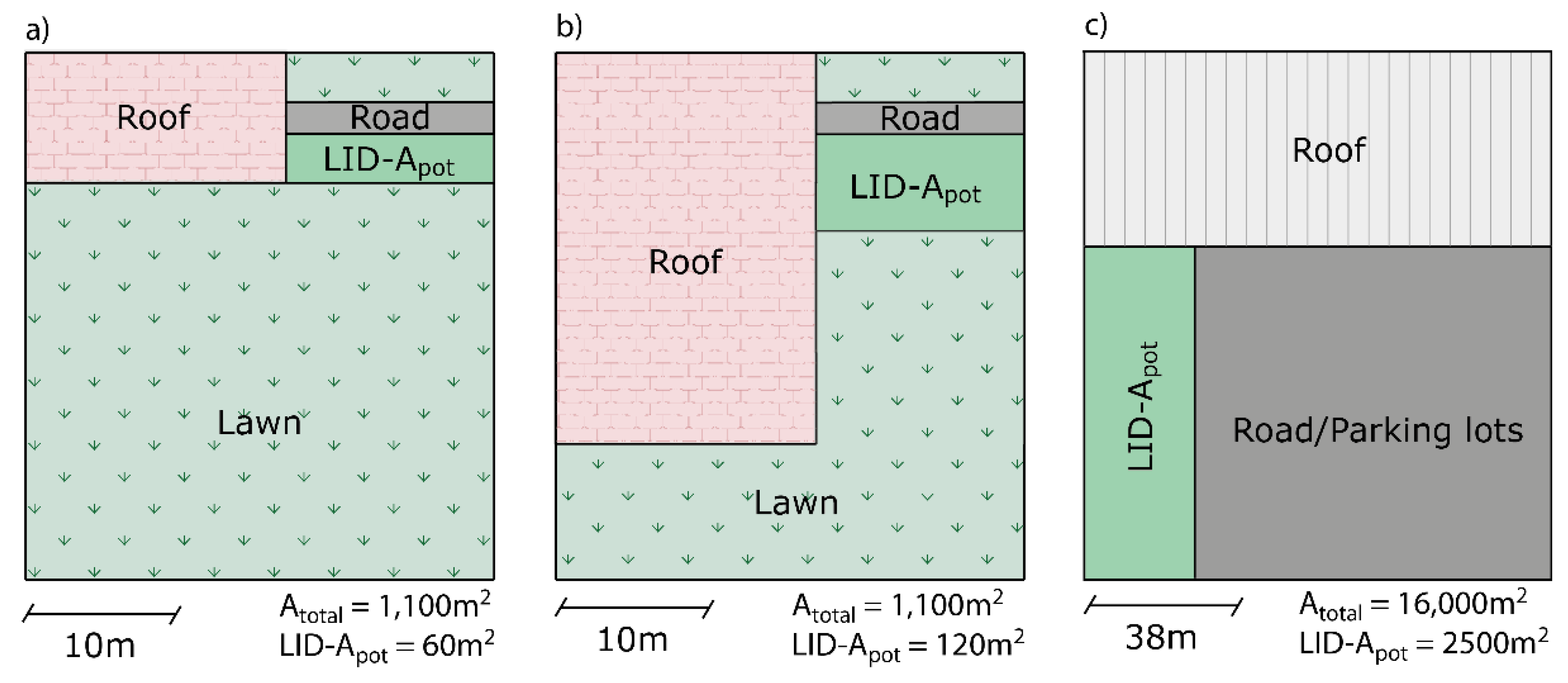
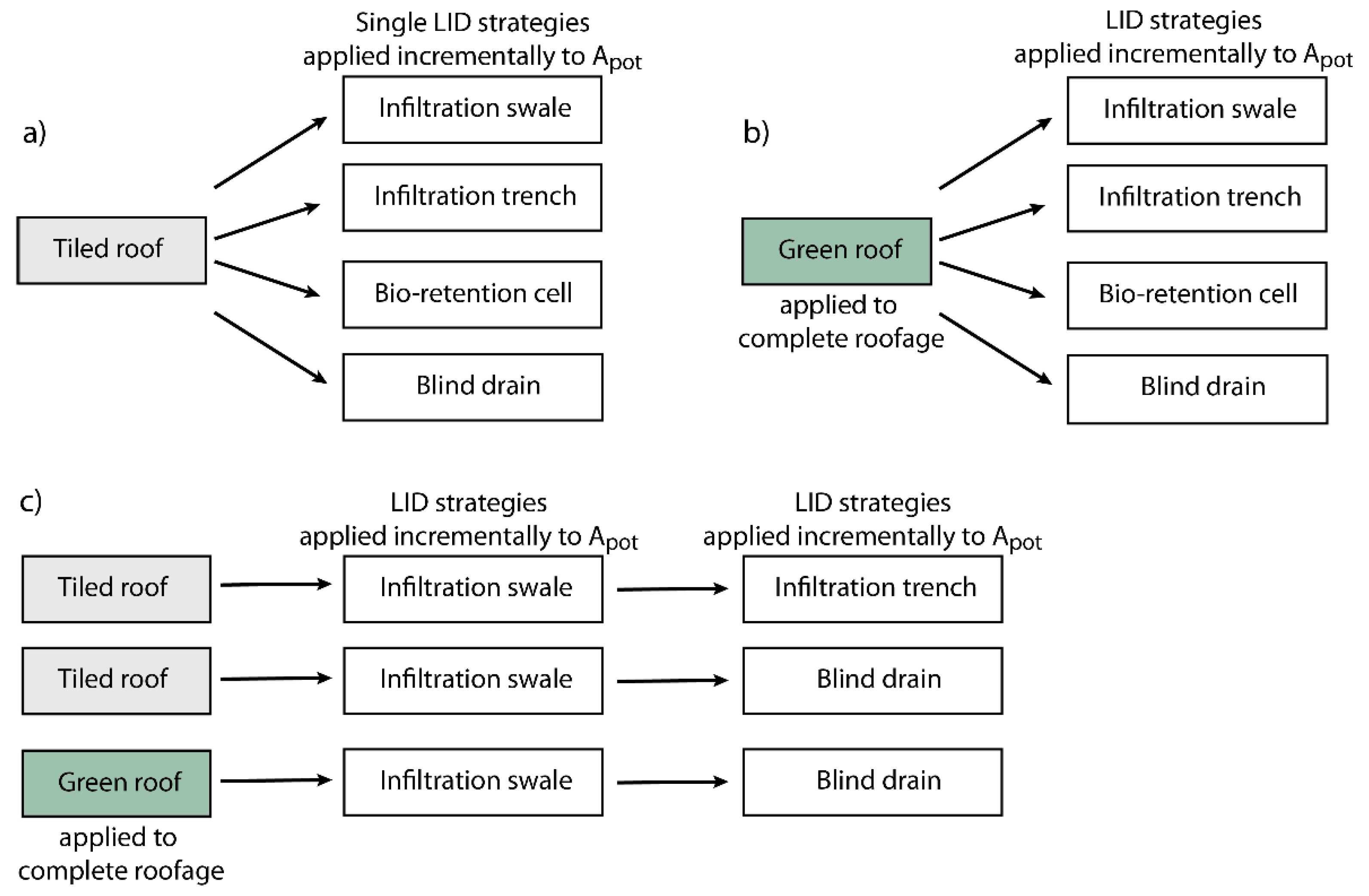

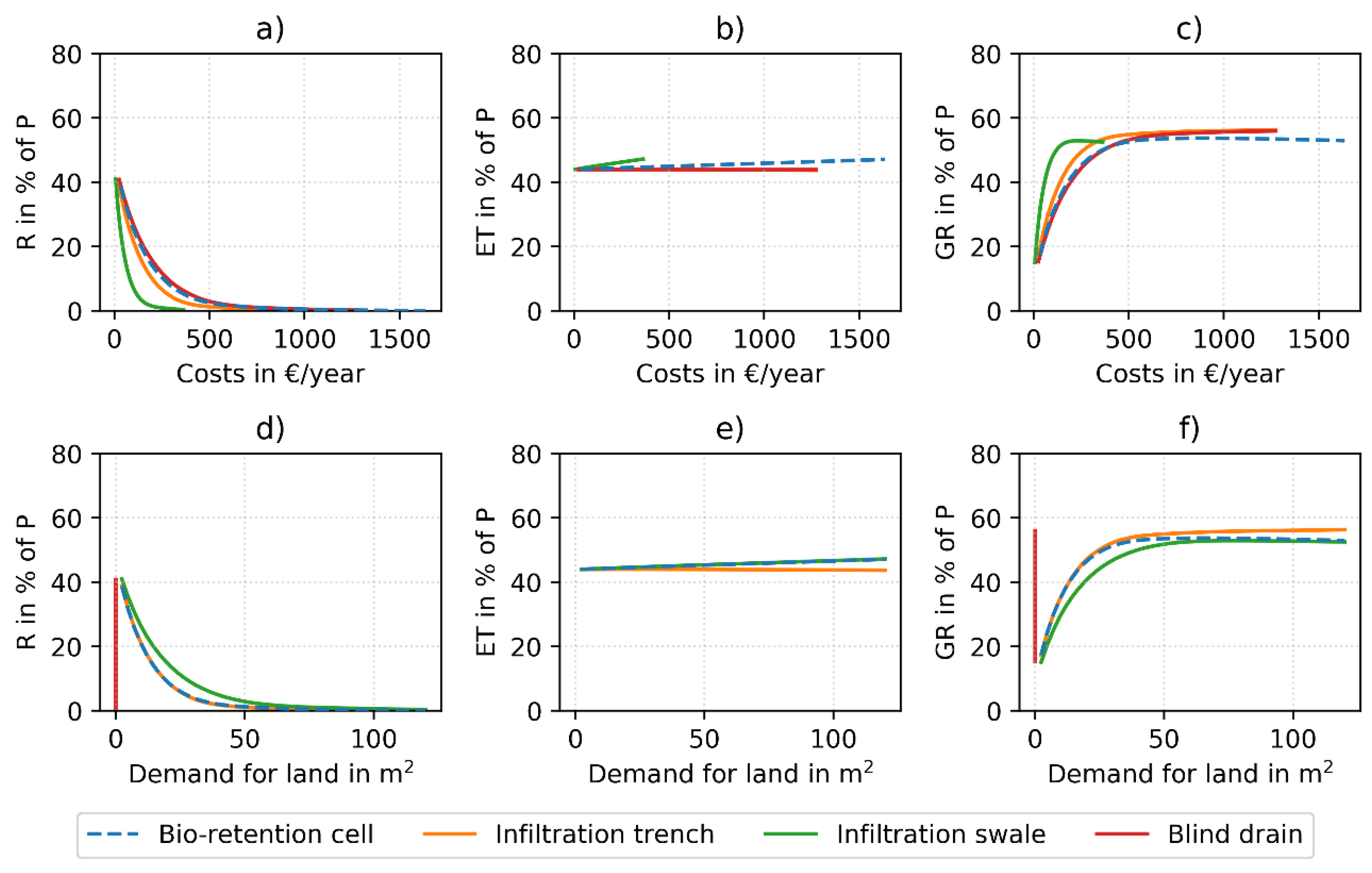
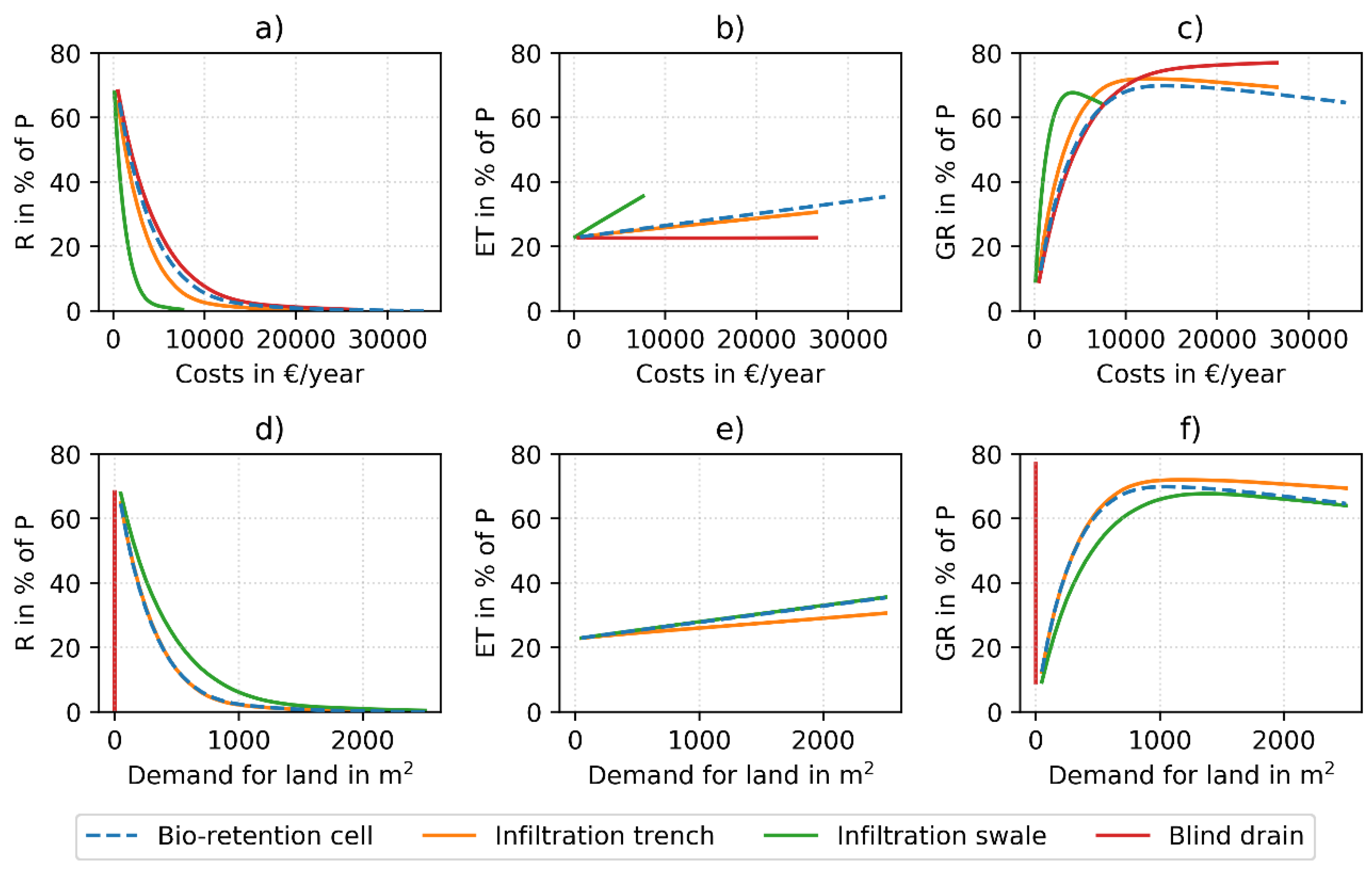
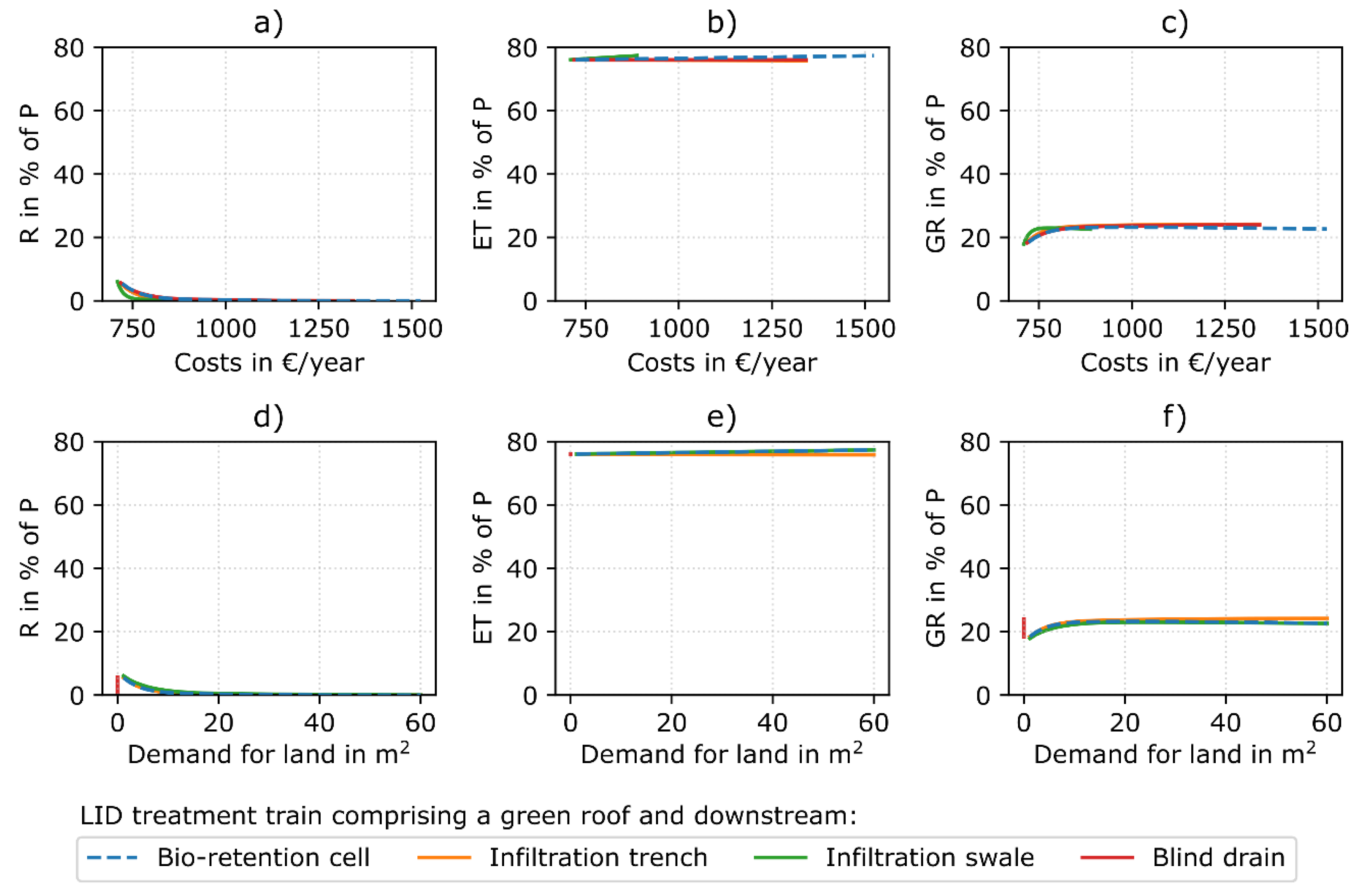


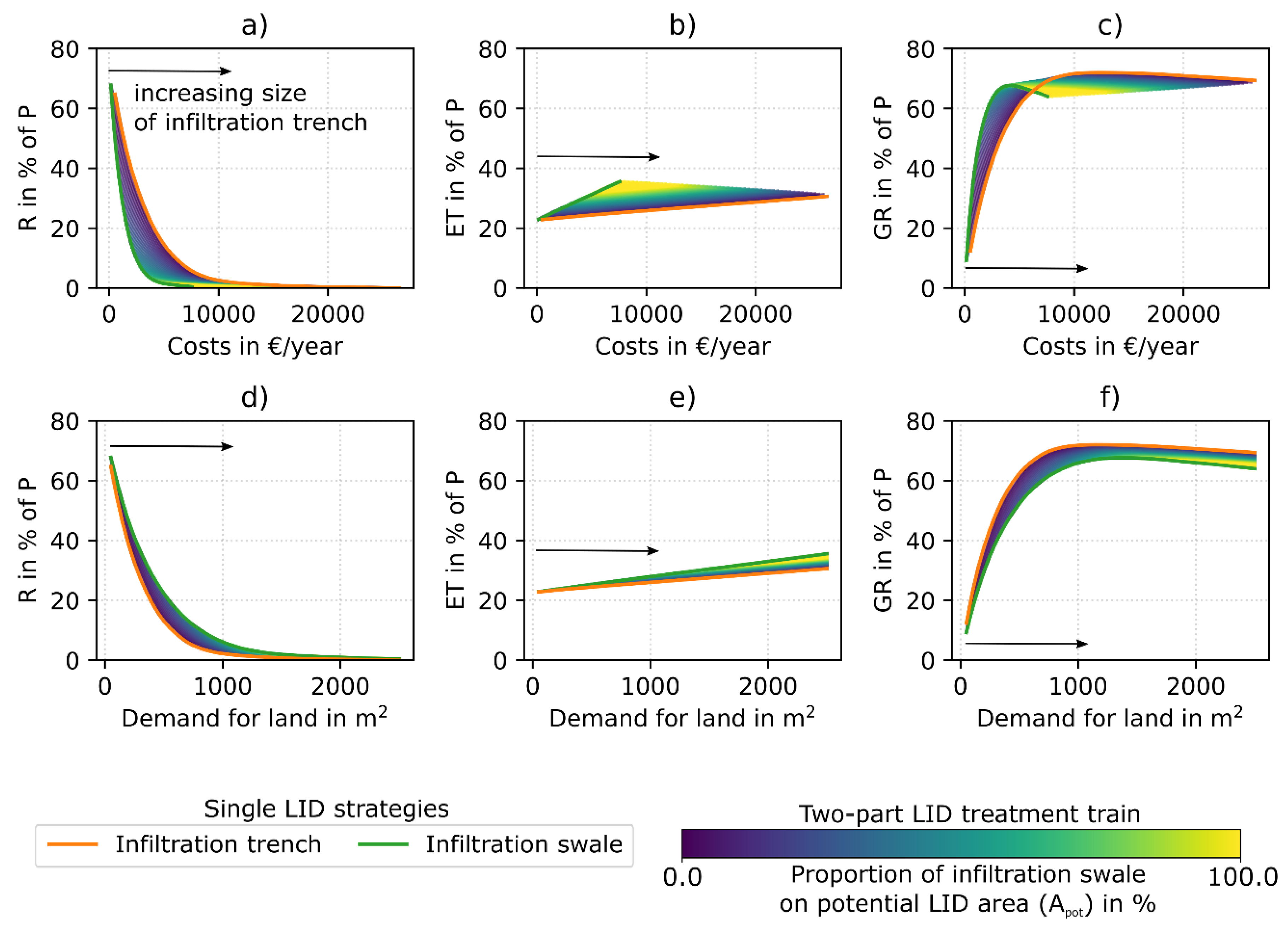
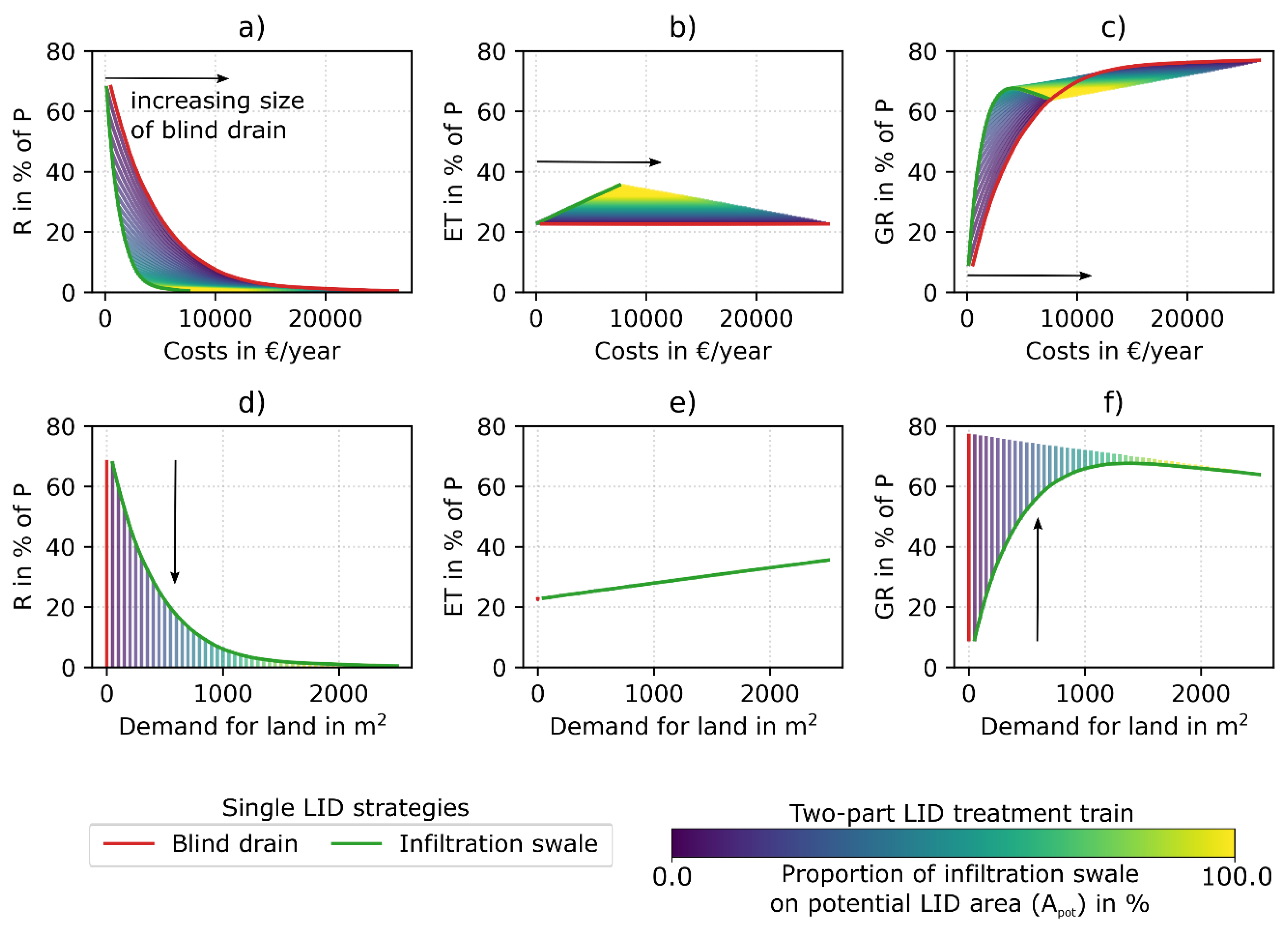

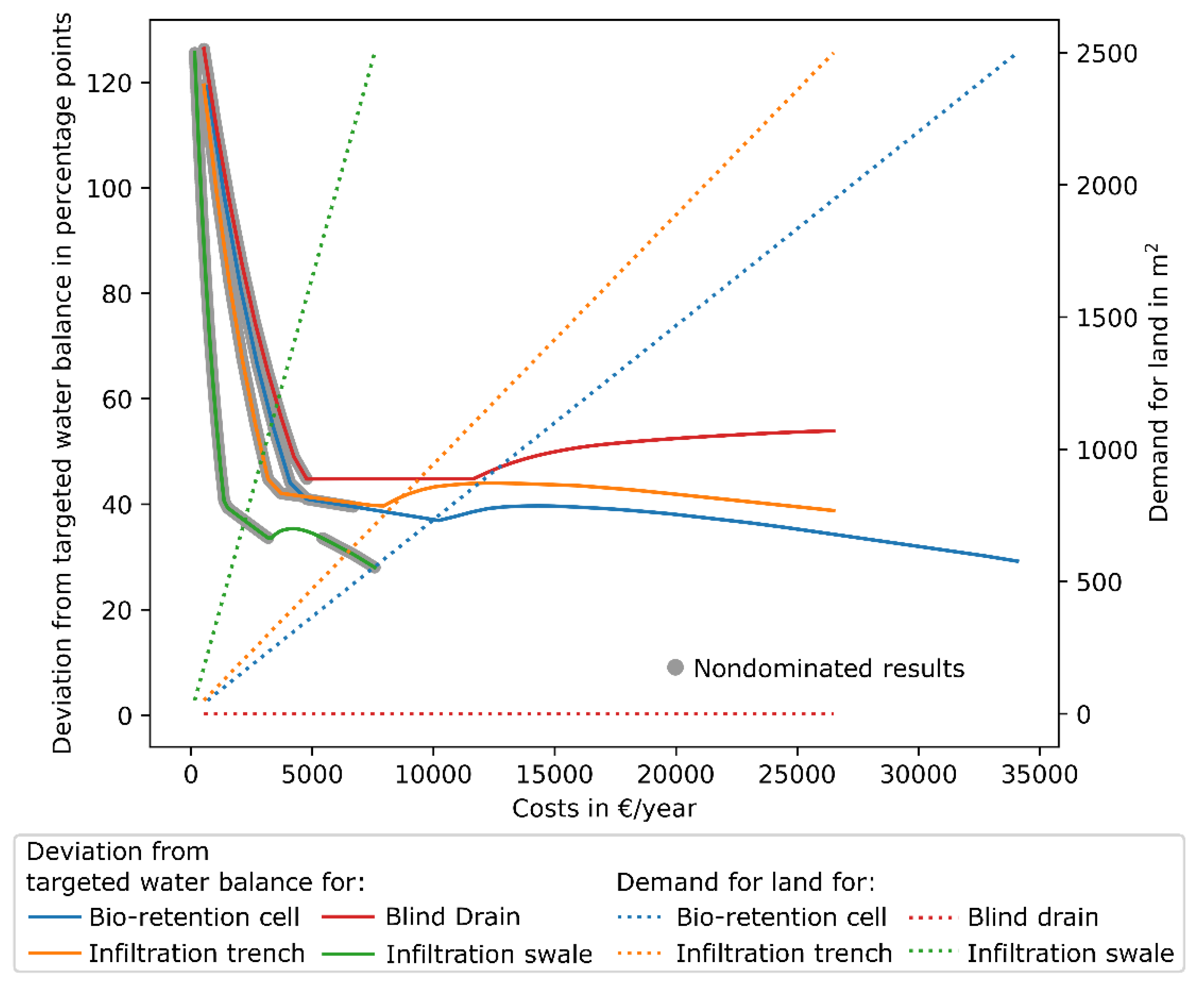
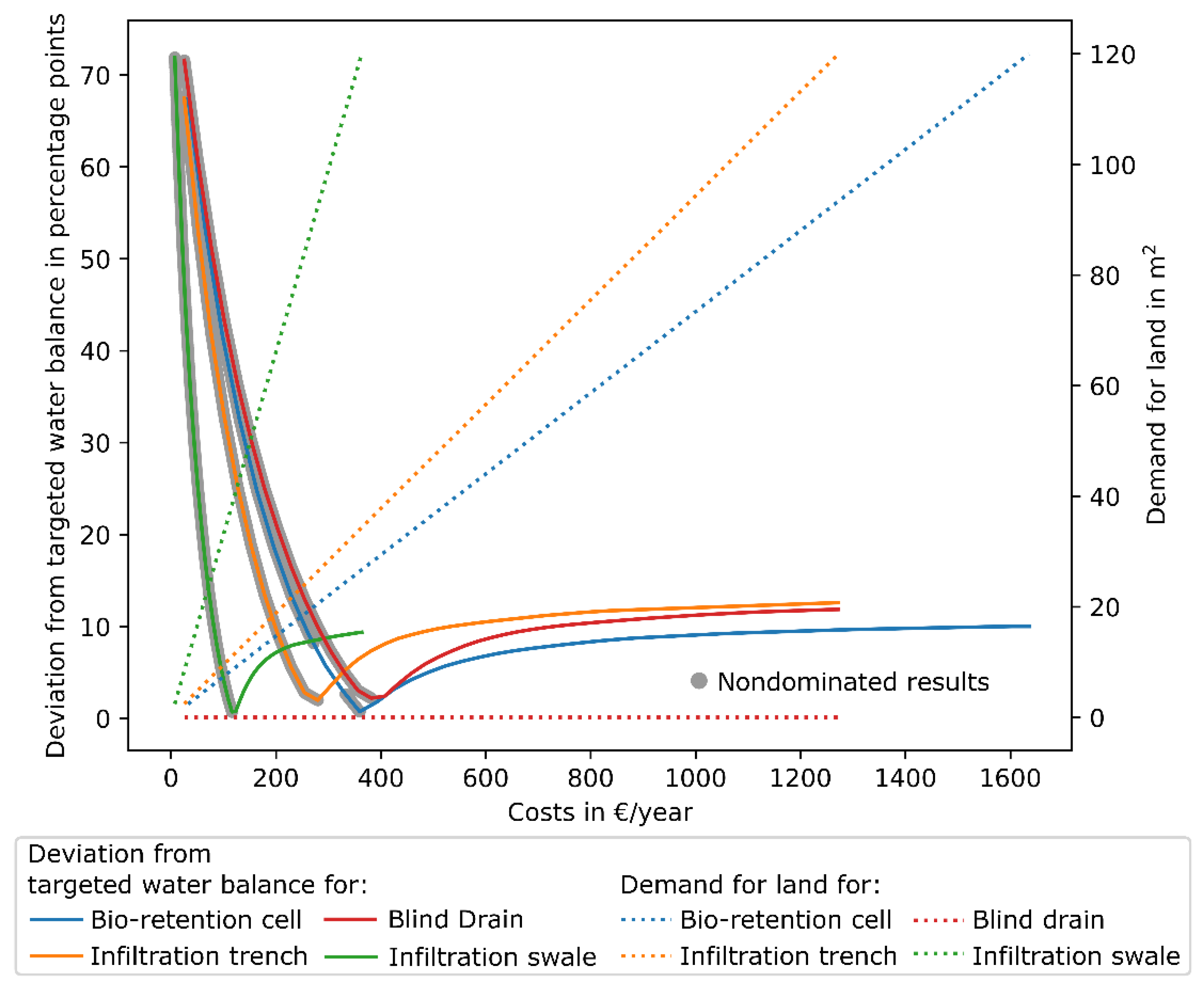
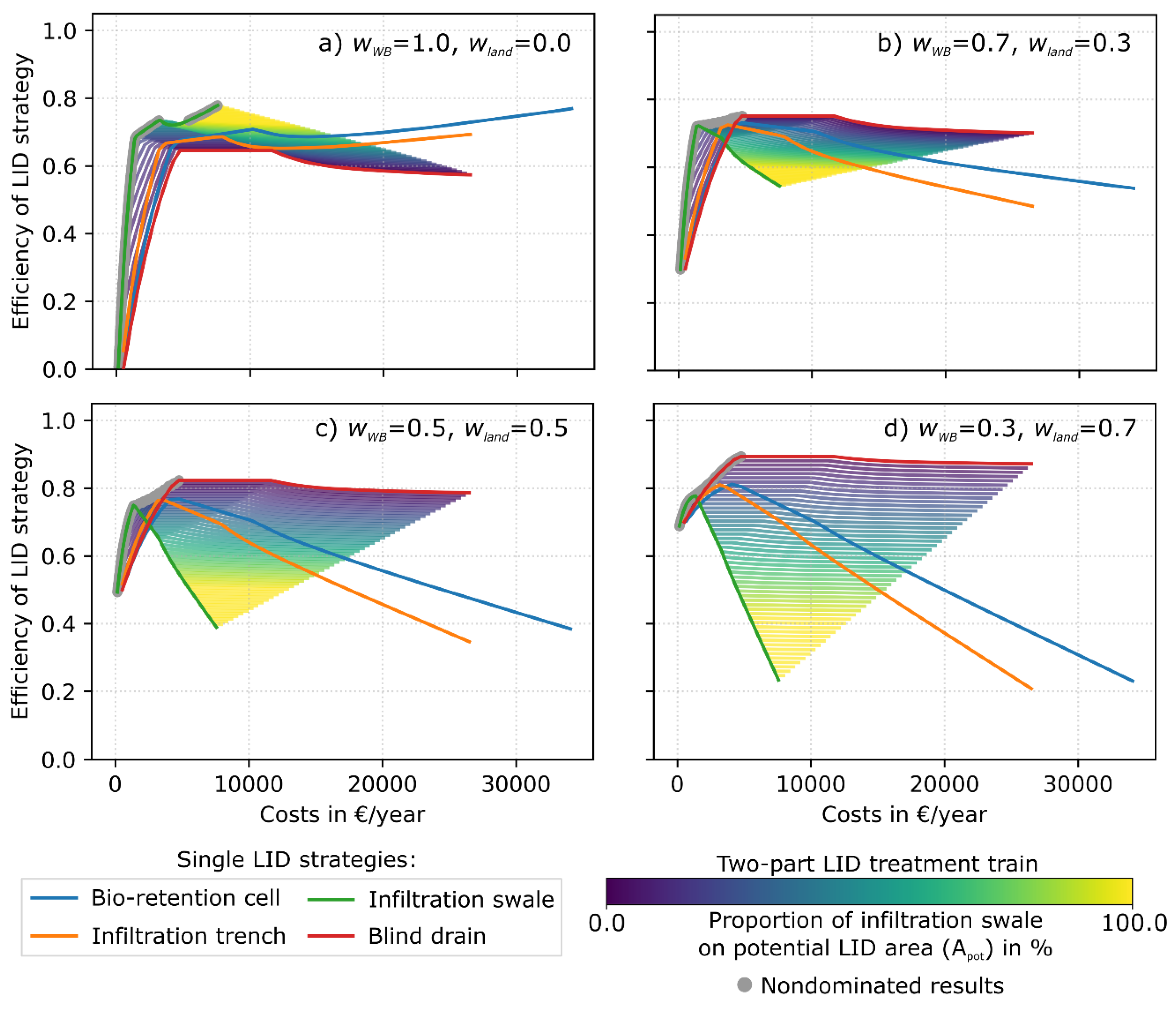
| Green roof | Infiltration trench | |||||
| Parameter | Unit | Parameter | Unit | |||
| Berm height | 10 | mm | Berm height | 300 | mm | |
| Vegetation volume | 0.2 | % | Vegetation volume | 0.0 | ||
| Surface roughness | 0.1 | s/m1/3 | Surface roughness | 0.02 | s/m1/3 | |
| Surface slope | 1.0 | % | Surface slope | 1.0 | % | |
| Soil thickness | 100 | mm | Storage thickness | 1000 | mm | |
| Porosity | 0.55 | - | Storage void ratio | 0.3 | - | |
| Field capacity | 0.4 | - | Storage seepage rate | 10 | mm/h | |
| Wilting point | 0.1 | - | ||||
| Conductivity | 50 | mm/h | ||||
| Conductivity slope | 30 | - | ||||
| Suction head | 65 | mm | ||||
| Drainage mat thickness | 30 | mm | ||||
| Drainage mat void fraction | 0.4 | - | ||||
| Drainage mat roughness | 0.02 | s/m1/3 | ||||
| Bio-retention cell | Infiltration swale | |||||
| Parameter | Unit | Parameter | Unit | |||
| Berm height | 300 | mm | Berm height | 300 | mm | |
| Vegetation volume | 0.1 | fraction | Vegetation volume | 0.1 | fraction | |
| Surface roughness | 0.16 | s/m1/3 | Surface roughness | 0.16 | s/m1/3 | |
| Surface slope | 1 | % | Surface slope | 1.0 | % | |
| Soil thickness | 300 | mm | Soil thickness | 300 | mm | |
| Porosity | 0.5 | - | Porosity | 0.5 | - | |
| Field capacity | 0.2 | - | Field capacity | 0.2 | - | |
| Wilting point | 0.1 | - | Wilting point | 0.1 | ||
| Conductivity | 120 | mm/h | Conductivity | 120 | mm/h | |
| Conductivity slope | 40 | - | Conductivity slope | 40 | - | |
| Suction head | 50 | mm | Suction head | 50 | mm | |
| Storage thickness | 100 | mm | ||||
| Storage void fraction | 0.3 | - | ||||
| Storage seepage rate | 10 | mm/h | ||||
| Construction Costs (C0) | Maintenance Costs (C0 ∙ p) | Total Costs (TCa) | Reference (Values Adapted) | ||||
|---|---|---|---|---|---|---|---|
| LID | |||||||
| Green roof | 35 | €/m² | 1.75 | €/(m²∙year) | 3.54 | €/(m²∙year) | [39,40,41] |
| Infiltration swale | 30 | €/m² | 1.5 | €/(m²∙year) | 3.03 | €/(m²∙year) | [38,39,40,41] |
| Infiltration trench | 105 | €/m³ | 5.25 | €/(m³∙year) | 10.61 | €/(m³∙year) | [38,39,40,41] |
| Bio-retention cell | 135 | €/m³ | 6.75 | €/(m³∙year) | 13.64 | €/(m³∙year) | [38,39,40,41] |
| Blind drain | 105 | €/m³ | 5.25 | €/(m³∙year) | 10.61 | €/(m³∙year) | [38,39,40,41] |
© 2019 by the authors. Licensee MDPI, Basel, Switzerland. This article is an open access article distributed under the terms and conditions of the Creative Commons Attribution (CC BY) license (http://creativecommons.org/licenses/by/4.0/).
Share and Cite
Leimgruber, J.; Krebs, G.; Camhy, D.; Muschalla, D. Model-Based Selection of Cost-Effective Low Impact Development Strategies to Control Water Balance. Sustainability 2019, 11, 2440. https://doi.org/10.3390/su11082440
Leimgruber J, Krebs G, Camhy D, Muschalla D. Model-Based Selection of Cost-Effective Low Impact Development Strategies to Control Water Balance. Sustainability. 2019; 11(8):2440. https://doi.org/10.3390/su11082440
Chicago/Turabian StyleLeimgruber, Johannes, Gerald Krebs, David Camhy, and Dirk Muschalla. 2019. "Model-Based Selection of Cost-Effective Low Impact Development Strategies to Control Water Balance" Sustainability 11, no. 8: 2440. https://doi.org/10.3390/su11082440
APA StyleLeimgruber, J., Krebs, G., Camhy, D., & Muschalla, D. (2019). Model-Based Selection of Cost-Effective Low Impact Development Strategies to Control Water Balance. Sustainability, 11(8), 2440. https://doi.org/10.3390/su11082440






